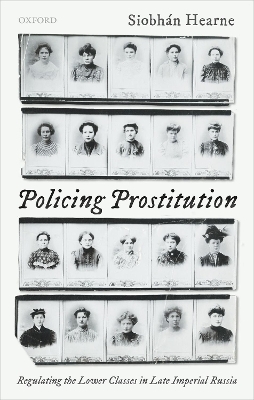
Policing Prostitution
Regulating the Lower Classes in Late Imperial Russia
Seiten
2021
Oxford University Press (Verlag)
978-0-19-883791-6 (ISBN)
Oxford University Press (Verlag)
978-0-19-883791-6 (ISBN)
Policing Prostitution examines the complex world of commercial sex in the late Russian Empire, investigating the lives of women who sold sex, the men who paid for it, mediators, the police, and wider urban communities.
Policing Prostitution examines the complex world of commercial sex in the late Russian Empire. From the 1840s until 1917, prostitution was legally tolerated across the Russian Empire under a system known as regulation. Medical police were in charge of compiling information about registered prostitutes and ensuring that they followed the strict rules prescribed by the imperial state governing their visibility and behaviour. The vast majority of women who sold sex hailed from the lower classes, as did their managers and clients. This study examines how regulation was implemented, experienced, and resisted amid rapid urbanization, industrialization, and modernization around the turn of the twentieth century. Each chapter examines the lives and challenges of different groups who engaged with the world of prostitution, including women who sold sex, the men who paid for it, mediators, the police, and wider urban communities.
Drawing on archival material from Russia, Ukraine, Belarus, Latvia, Lithuania, and Estonia, Policing Prostitution illustrates how prostitution was an acknowledged, contested, and ever-present component of lower-class urban society in the late imperial period. In principle, the tsarist state regulated prostitution in the name of public order and public health; in practice, that regulation was both modulated by provincial police forces who had different local priorities, resources, and strategies, and contested by registered prostitutes, brothel madams, and others who interacted with the world of commercial sex.
Policing Prostitution examines the complex world of commercial sex in the late Russian Empire. From the 1840s until 1917, prostitution was legally tolerated across the Russian Empire under a system known as regulation. Medical police were in charge of compiling information about registered prostitutes and ensuring that they followed the strict rules prescribed by the imperial state governing their visibility and behaviour. The vast majority of women who sold sex hailed from the lower classes, as did their managers and clients. This study examines how regulation was implemented, experienced, and resisted amid rapid urbanization, industrialization, and modernization around the turn of the twentieth century. Each chapter examines the lives and challenges of different groups who engaged with the world of prostitution, including women who sold sex, the men who paid for it, mediators, the police, and wider urban communities.
Drawing on archival material from Russia, Ukraine, Belarus, Latvia, Lithuania, and Estonia, Policing Prostitution illustrates how prostitution was an acknowledged, contested, and ever-present component of lower-class urban society in the late imperial period. In principle, the tsarist state regulated prostitution in the name of public order and public health; in practice, that regulation was both modulated by provincial police forces who had different local priorities, resources, and strategies, and contested by registered prostitutes, brothel madams, and others who interacted with the world of commercial sex.
Siobhán Hearne is a historian of gender and sexuality in the Russian Empire and the Soviet Union. She is currently a Leverhulme Early Career Fellow in the School of Modern Languages and Cultures at Durham University. She received her PhD from the University of Nottingham in 2017, and has since completed postdoctoral research in Latvia, Estonia, and Lithuania. Her research has appeared in the journals Kritika: Explorations in Russian and Eurasian History, Social History, Revolutionary Russia and The Journal of Social History(forthcoming).
Introduction
1: Selling Sex
2: Paying for Sex
3: Managing Commercial Sex
4: Policing Commercial Sex
5: Living with Commercial Sex
Conclusion
Bibliography
| Erscheinungsdatum | 09.06.2021 |
|---|---|
| Zusatzinfo | 16 black and white figures/maps |
| Verlagsort | Oxford |
| Sprache | englisch |
| Maße | 165 x 240 mm |
| Gewicht | 518 g |
| Themenwelt | Geschichte ► Allgemeine Geschichte ► Neuzeit (bis 1918) |
| Geschichte ► Teilgebiete der Geschichte ► Kulturgeschichte | |
| Studium ► 1. Studienabschnitt (Vorklinik) ► Med. Psychologie / Soziologie | |
| ISBN-10 | 0-19-883791-7 / 0198837917 |
| ISBN-13 | 978-0-19-883791-6 / 9780198837916 |
| Zustand | Neuware |
| Haben Sie eine Frage zum Produkt? |
Mehr entdecken
aus dem Bereich
aus dem Bereich
Europa 1848/49 und der Kampf für eine neue Welt
Buch | Hardcover (2023)
DVA (Verlag)
48,00 €
Giordano Bruno - ein ketzerisches Leben
Buch | Hardcover (2024)
C.H.Beck (Verlag)
29,90 €


